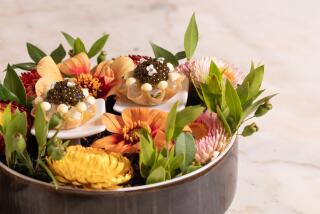This superstar French chef served Europe’s upper crust
Antonin CAREME, who served as chef to such luminaries as Napoleon, Talleyrand, Czar Alexander I, the British prince regent and the Rothschilds, was born in the slums of Paris, circa 1783, probably the 16th of 24 children. In the last months of 1792, when the streets of Paris were filled with the bloodiest violence of the Revolution, 9-year-old Antonin was blithely turfed out of his home by his father, who “took him to the busy Maine gate of Paris and left him with these words: ‘Nowadays you need only the spirit to make your fortune ... and you have that spirit. Va petit! -- With what God has given you.’ ”
The terrified child was taken in by a cook, and the rest was to be history, or more accurately, culinary history, with a bit of mythologizing embellishment. There is no doubt, however, that this bright, hardworking boy -- a self-taught reader who, after his kitchen duties, rushed to the Bibliotheque Nationale to devour books on food and architecture -- possessed the passion, discipline and dedication to rise to the heights of his profession.
The drama and excitement of Careme’s colorful life story has certainly not been lost on Ian Kelly, a British food and travel writer who has written and performed a one-man play about him. He begins this book with a snapshot of Careme at the peak of his fame, working on a special banquet for the Rothschilds, who were paying him 8,000 francs a year for his occasional services. Though far from the most elaborate menu ever devised by Careme, this elegant meal featured two soups, sea bass, cod a la hollandaise, lamb, beef, quail, chicken, rabbit, pigeon, vol-au-vents, cockscombs, braised lettuce, haricots verts, oranges stuffed with marbled orange jellies and nectarine ice cream, in addition to “La Sultane a la Colonne,” a centerpiece made of spun sugar in the shape of a classical Greek temple that would remain on the table throughout the evening.
Yet, at 45, the most highly paid chef in Europe (and also the author of bestselling food books) was far from well. Pale, weak in his left arm, having difficulty breathing, Careme believed he knew what was wrong: “He had seen the same in older colleagues and friends; he was slowly dying from the poisonous fumes of a lifetime of cooking over charcoal .... “
Not much is known of Careme’s personal life: After seven years of marriage, he set up house with a younger woman who’d borne him a daughter. Unlike their counterparts today, celebrities of yore, though eager to vaunt their public triumphs, seldom wished to divulge the details of their private lives.
Curiously, this lack of “dish” is what makes “Cooking for Kings” such an interesting and unusual biography. The focus is on history -- social, political, diplomatic and culinary -- and, of course, on food: actual dishes, including Careme’s original recipes and menus for banquets. Kelly aptly remarks that just as the novel set the tone for British manners and mores, in post-Revolutionary France, gastronomy served as the guide.
Careme’s first important employer, the wily, engaging Count Talleyrand, used fine dining as a tool of diplomacy. A guest at one of his meals recalled how the count “analyzed the dinner with the interest and seriousness accorded to a political problem.” Napoleon, however, cared less about food, and grew impatient at long banquets. Careme’s royal British employer, the prince regent -- the future George IV -- was so overweight, his uncorseted stomach reached to his knees. Enticed to the imperial court of St. Petersburg, Careme was charmed by the Russian custom of setting the table with flowers but shocked at the autocratic organization of a staff that encompassed thousands, including the slaves or serfs.
The greatest influence on dining Careme helped introduce in the West, however, was also of Russian origin. In place of the traditional service a la Francaise, which involved huge banquet tables laden with scores of dishes all at once, Careme favored service a la Russe -- a meal with multiple courses served in turn: more democratic, more civilized and certainly conducive to better eating.
Attractively illustrated with paintings, drawings, menus and recipes, written with verve and savoir-faire, “Cooking for Kings” offers a diverting, often eye-opening, glimpse of a turbulent era commingling revolution, reaction, elegance and excess.
More to Read
Eat your way across L.A.
Get our weekly Tasting Notes newsletter for reviews, news and more.
You may occasionally receive promotional content from the Los Angeles Times.









